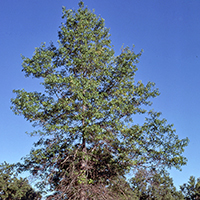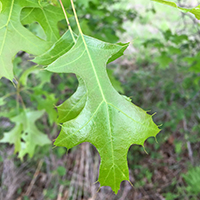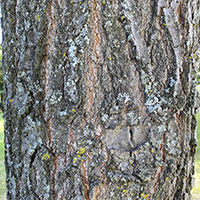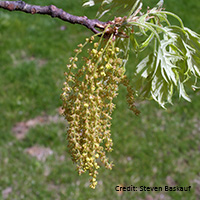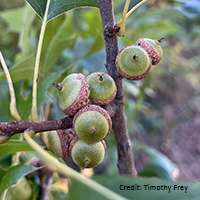What pin oak looks like
Size and shape
- Reaches 20 metres high.
- Trunk reaches up to 1 metre in diameter.
- Lower branches often die and point downward, giving the tree a messy appearance.
Leaves
- Dark green with 5 to 7 lobes divided by U-shaped notches (7 to 15 centimetres).
- Larger lobes can have bristle-tipped teeth.
Bark
- Greyish-brown outer bark is thin and smooth when young.
- Ridges develop with age.
- Inner bark is reddish.
Flowers
- Male flowers are small and grow as drooping catkins.
- Female flowers are small and grow in few-flowered clusters or spikes.
- Flowers bloom with the leaves.
Fruit
- Acorns (9 to 13 millimetres) contain 1 seed and are short-beaked at the tip.
- Reddish-brown cap (12 to 16 millimetres) covers about one quarter of the nut.
Where pin oak is found
Pin oak is found in the Carolinian Zone, which is the southern-most portion of Ontario. It has also been planted beyond its natural range as an ornamental tree.
What you need to know to grow pin oak
- Moisture: grows best in moist, well-drained soils but tolerates moderate flooding.
- Soil: grows most commonly on moist to wet moderately to slightly acid clay and sand.
- Shade: grows best in full sun.
- Caution:
- oak wilt is caused by an invasive fungus that has been found in Southern Ontario. To minimize risk of oak wilt, save pruning for before April and after July, when beetles thought to transport the fungus are less active.
Benefits and uses of pin oak
Wildlife benefits
Pin oak nuts are a food source for many birds and mammals, including:
- white-tailed deer
- wild turkeys
- squirrels
- ducks
Commercial uses
Pin oak wood is hard and strong. It can be used to make:
- cabinetry
- furniture
- interior trim
- flooring
- veneer
Fun facts about pin oak
- Pin oak trees can live up to 100 years.
- Pin oak gets its name from the short, tough branchlets — which resemble pins — growing on its branches.
Updated: July 07, 2025
Published: July 18, 2014
